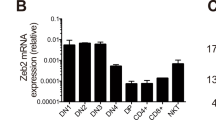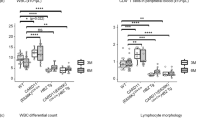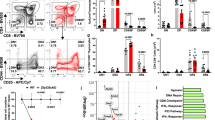Abstract
CDC42, a Ras-related small GTP binding protein, is involved in diverse cellular functions in lymphocytes. We generated transgenic mice expressing constitutively active murine CDC42 (Q61L) under the control of the human CD2 promoter. Transgenic mice showed smaller thymi with a dramatic reduction of CD4+CD8+, CD4+ and CD8+ thymocytes and with increase of CD4−CD8− thymocytes at CD25−CD44+ and CD25+ stage. A high percentage of the transgenic thymocytes were apoptotic, explaining the reduction of cellularity and size of the thymus. Mature T cells (TCR αβ+) in peripheral lymph organs, spleen and lymph node, were also dramatically reduced, and exhibited massive apoptosis. Expression of Fas and Fas ligand on both thymocytes and peripheral T cells was upregulated in transgenic mice, but the increased apoptosis in the thymus was independent of Fas (CD95), whereas peripheral spleen and lymph node T cell apoptosis was Fas dependent. Thus, activated CDC42 triggers distinct apoptotic pathways in thymocytes and peripheral T cells.
This is a preview of subscription content, access via your institution
Access options
Subscribe to this journal
Receive 50 print issues and online access
$259.00 per year
only $5.18 per issue
Buy this article
- Purchase on Springer Link
- Instant access to full article PDF
Prices may be subject to local taxes which are calculated during checkout








Similar content being viewed by others
Abbreviations
- PCR:
-
polymerase chain reaction
- DN:
-
double negative
- DP:
-
double positive
- SP:
-
single positive
- TCR:
-
T cell receptor
- JNK:
-
c-jun N-terminus kinase
References
Abbas AK. . 1996 Cell 84: 655–657.
Alan A, Bram MY, Hatrges F, Lesage S, Cohen L, Hugo P, Denis F and Sekaly R. . 1997 J. Exp. Med. 186: 1503–1512.
Amakawa R, Hakem A, Kundig TM, Matuyama T, Simard JJ, Timma E, Wakehem A, Mittruecker HW, Griesser H, Takimoto H, Schmits R, Shahinian A, Ohashi P, Penninger JM and Mark TW. . 1996 Cell 84: 551–562.
Avraham A, Jung S, Samual Y, Seger R and Ben-Neriah Y. . 1998 Eur. J. Immunol. 28: 2320–2330.
Bagrodia S, Dérijard B, Davis RJ and Cerione RA. . 1995 J. Biol. Chem. 270: 27995–27998.
Boldin MP, Goncharov TM, Goltsev YV and Wallah D. . 1996 Cell 85: 803–815.
Bourne HR and McCormick F. . 1991 Nature 349: 117–127.
Chuang TH, Hahn KM, Lee JD, Danley DE and Bokoch GM. . 1997 Molec. Biol. Cell 8: 1687–1698.
Coso OA, Chiariello M, Yu JC, Teramoto H, Crespo P, Xu N, Miki T and Gutkind SJ. . 1995 Cell 81: 1137–1146.
Faris M, Kokot N, Latinis K, Kasibhatla S, Green DR, Koretzky GA and Nel A. . 1998 J. Immunol. 160: 134–144.
Galandrini R, Henning SW and Cantrell DA. . 1997 Immunity 7: 163–174.
Gavrieli Y, Sherman Y and Ben-Sasson SA. . 1992 J. Biol. Chem. 119: 493–501.
Godfrey DI, Kennedy J, Suda T and Zlotnik A. . 1993 J. Immunol. 150: 4244–4252.
Habets GM, Stam JC, Berns A and Collard JG. . 1994 Cell 77: 537–548.
Hall A. . 1998 Science 279: 509–514.
Henning SW, Galandrini R, Hall A and Cantrell DA. . 1997 EMBO J. 16: 2397–2407.
Hill CS, Wynne J and Treisman R. . 1995 Cell 81: 1159–1170.
Hogan B, Constantini F and Lacy E. . (1986 Manipulating the mouse embryo. Cold Spring Harbor Laboratory Press, Cold S pring Harbor, NY. 217–248.
Kabelitz D, Pohl T and Pechold K. . 1993 Immunol. Today 14: 338–339.
Kaga S, Ragg S, Rogers KA and Ochi A. . 1998 J. Immunol. 160: 4182–4189.
Kasibhatla S, Brunner T, Genestier L, Echeverii F, Mahboubi A and Green DR. . 1998 Molec. Cell 1: 543–551.
Levin SD, Anderson SJ, Forbush KA and Perlmutter RM. . 1993 The EMBO J. 12: 1671–1680.
Lin R, Bagrodia S, Cerione R and Manor D. . 1997 Curr. Biol. 7: 794–797.
Linette GP and Korsmeyer SJ. . 1994 Curr. Biol. 6: 809–815.
Lores P, Morin L, Lina R and Gacon G. . 1997 Oncogene 15: 601–605.
Martin SJ, Reutelingsperger CP, McGahon AJ, Rader JA, Van Schie RC, Laface DM and Green DR. . 1995 J. Exp. Med. 182: 1545–1556.
Mehal WZ and Crispe IN. . 1998 J. Immunol. 1686–1693.
Minden A, Lin A, Claret F, Abo A and Karin M. . 1995 Cell 81: 1147–1157.
Moorman JP, Bobak DA and Hahn CS. . 1996 J. Immunol. 156: 4146–4153.
Muzio M, Chinnaiyan AM, Kischkel FC, O'Rourke K, Shevchenko A, Ni J, Scaffidi C, Mann M, Krammer PH, Peter ME and Dixit VM. . 1996 Cell 85: 817–827.
Na S, Chuang T-H, Cunnigham A, Turi GT, Hanke JH, Bokoch GM and Danley DE. . 1996 J. Biol. Chem. 271: 11209–11213.
Nagata S and Golstein P. . 1995 Science 267: 1449–1455.
Nossal GJV. . 1994 Cell 76: 229–239.
Olson MO, Ashworth A and Hall A. . 1995 Science 269: 1270–1272.
Perona R, Montaner S, Saniger LIS-P, Bravo R and Carlos Lacal J. . 1997 Genes & Development 11: 463–475.
Raingeaud J, Gupta S, Roger JS, Dickens M, Han J, Ulevitch RJ and Davis RJ. . 1995 J. Biol. Chem. 270: 7420–7426.
Rincón M, Yang D, Whitmarsh A, Weiss L, Dérijard B, Jayaraj P, Davis RJ and Flavell RA. . 1998 J. Exp. Med. 188: 1817–1830.
Sidman CL, Marshall JD and von Boehmer H. . 1992 Eur. J. Immunol. 22: 499–504.
Stowers L, Yelon D, Berg LJ and Chant J. . 1995 Proc. Natl. Acad. Sci. USA 92: 5027–5031.
Su B, Jacinto E, Hibl M, Kallunki T, Karin M and Ben-Neriah Y. . 1994 Cell 77: 727–736.
Swan KA, Alberola-Ila J, Gross JA, Appleby MW, Forbush KA, Thomas JF and Perlmutter RM. . 1995 EMBO J. 14: 276–285.
Turner M, Mee PJ, Walthers AE, Quinn ME, Mellor AL, Zamoyska R and Tybulewicz LJ. . 1997 Immunity 7: 451–460.
von Boehmer H. . 1988 Annu. Rev. Immunol. 6: 309–326.
von Boehmer H. . 1994 Cell 76: 219–228.
von Freeden-Jeffry U, Solvason N, Howard M and Murray R. . 1997 Immunity 7: 147–154.
Webb SR, Hutchinson J, Hayden K and Sprent JJ. . 1994 J. Immunol. 152: 586–597.
Xia Z, Dickens M, Raingeand J, Davis RJ and Greenberg ME. . 1995 Science 270: 1326–1331.
Yang DD, Kuan CY, Whitmarsh AJ, Rincón M, Zheng TS, Davis RJ and Flavell RA. . 1997 Nature 389: 865–870.
Zhumanekov T, Corbella P, Tolaini M and Kioussis D. . 1995 J. Immunol. Methods 185: 133–140.
Acknowledgements
We thank C Hughes and D Butkus for help in generating transgenic mice, J Miller for technical support, T Taylor for flow cytometry, and F Manzo for help in manuscript preparation. S Na was supported by a Pfizer Inc. postdoctoral fellowship. These studies were supported by grant CA65861 and CA72009 from the National Cancer Institute (RJD). IS Grewal was an Associate, B Li is an Associate, RJ Davis and RA Flavell are Investigators of the Howard Hughes Medical Institute.
Author information
Authors and Affiliations
Rights and permissions
About this article
Cite this article
Na, S., Li, B., Grewal, I. et al. Expression of activated CDC42 induces T cell apoptosis in thymus and peripheral lymph organs via different pathways. Oncogene 18, 7966–7974 (1999). https://doi.org/10.1038/sj.onc.1203122
Received:
Revised:
Accepted:
Published:
Issue Date:
DOI: https://doi.org/10.1038/sj.onc.1203122
Keywords
This article is cited by
-
Role of Rho GTPases in inflammatory bowel disease
Cell Death Discovery (2023)
-
RhoG regulates gene expression and the actin cytoskeleton in lymphocytes
Oncogene (2003)



